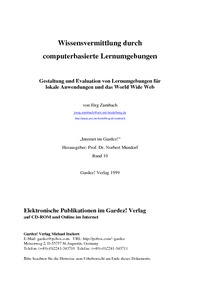Wissensvermittlung durch computerbasierte LernumgebungenGestaltung und Evaluation von Lernumgebungen für lokale Anwendungen und das World Wide Web
|

|
 Diese Seite wurde seit 17 Jahren inhaltlich nicht mehr aktualisiert.
Unter Umständen ist sie nicht mehr aktuell.
Diese Seite wurde seit 17 Jahren inhaltlich nicht mehr aktualisiert.
Unter Umständen ist sie nicht mehr aktuell.
 Zusammenfassungen
Zusammenfassungen
 The use of computers for educational and instructional purposes has become a more and more
important field in Educational Psychology. This work deals with the possibilities of enhancing
students‘ motivation and information processing with computer-based learning environments.
Central attention is given to the use of hypertextual information in different computer programs.
Three different kinds of learning environments have been developed: a Computer-Based Tutorial,
a Goal-Based Scenario and a „pure“ Hypertext-environment. All three programs contain the
same ecological hypertextual information about the influence and factors of oil and sea and were
able to be used on local platforms and through a Web-Browser. Assessing students‘ structural
knowledge through a concept-mapping method showed evidence of enhanced knowlege acquisition
through the situated learning environment of the Goal-Based Scenario (GBS). An investigation
of motivational factors showed significant decrease of learners‘ motivation in the Hypertext
and the Tutorial environment, while the GBS supported the maintainance of motivated information
processing. Similar results have been found assessing informal reasoning through argumentation.
The group participating in the GBS developed a broader, more rational and more balanced
reasoning related to a given provocative hypothesis. Tests about the memorizing of single facts
showed advantages of the Tutorial.
The use of computers for educational and instructional purposes has become a more and more
important field in Educational Psychology. This work deals with the possibilities of enhancing
students‘ motivation and information processing with computer-based learning environments.
Central attention is given to the use of hypertextual information in different computer programs.
Three different kinds of learning environments have been developed: a Computer-Based Tutorial,
a Goal-Based Scenario and a „pure“ Hypertext-environment. All three programs contain the
same ecological hypertextual information about the influence and factors of oil and sea and were
able to be used on local platforms and through a Web-Browser. Assessing students‘ structural
knowledge through a concept-mapping method showed evidence of enhanced knowlege acquisition
through the situated learning environment of the Goal-Based Scenario (GBS). An investigation
of motivational factors showed significant decrease of learners‘ motivation in the Hypertext
and the Tutorial environment, while the GBS supported the maintainance of motivated information
processing. Similar results have been found assessing informal reasoning through argumentation.
The group participating in the GBS developed a broader, more rational and more balanced
reasoning related to a given provocative hypothesis. Tests about the memorizing of single facts
showed advantages of the Tutorial. Dieses Buch erwähnt ...
Dieses Buch erwähnt ...
 Personen KB IB clear | Katherine Beissner , John Seely Brown , Allan Collins , Mihaly Csikszentmihalyi , Hubert L. Dreyfus , E. D. Gagné , Hans Gruber , Ludwig J. Issing , J.-C. Jehng , David H. Jonassen , Paul Klimsa , Rainer Kuhlen , Heinz Mandl , S. E. Newmann , Donald A. Norman , Seymour Papert , Jean Piaget , M. R. Quillian , Alexander Renkl , D. E. Rumelhart , Rolf Schulmeister , Burrhus F. Skinner , R. J. Spiro , Michael Yacci | ||||||||||||||||||||||||||||||||||||||||||||||||||||||||||||||||||||||||||||||||||||||||||||||||||||||||||||||||||||||||||||||||||||||||||||||||
 Begriffe KB IB clear | cognitive apprenticeshipcognitive apprenticeship
, cognitive flexibilitycognitive flexibility
, Cognitive Toolscognitive tools
, Concept MapConcept Map
, Evaluationevaluation
, goal based scenariogoal based scenario
,  Hypertext Hypertext hypertext
, Informationinformation
, hypertext
, Informationinformation
,  Lernen Lernen learning
, Lernumgebung
, microworldmicroworld
, learning
, Lernumgebung
, microworldmicroworld
,  Motivation Motivation motivation
, motivation
,  Wissen Wissen
| ||||||||||||||||||||||||||||||||||||||||||||||||||||||||||||||||||||||||||||||||||||||||||||||||||||||||||||||||||||||||||||||||||||||||||||||||
 Bücher |
| ||||||||||||||||||||||||||||||||||||||||||||||||||||||||||||||||||||||||||||||||||||||||||||||||||||||||||||||||||||||||||||||||||||||||||||||||
 Texte |
|
 Dieses Buch erwähnt vermutlich nicht ...
Dieses Buch erwähnt vermutlich nicht ... 
 Nicht erwähnte Begriffe | anchored instruction, Concept Mapping Software, Wissensmanagement |
 Tagcloud
Tagcloud
 Zitationsgraph
Zitationsgraph
 Zitationsgraph (Beta-Test mit vis.js)
Zitationsgraph (Beta-Test mit vis.js)
 Zeitleiste
Zeitleiste
 Volltext dieses Dokuments
Volltext dieses Dokuments
 |  Wissensvermittlung durch computerbasierte Lernumgebungen: Gesamtes Buch als PDF-Datei ( Wissensvermittlung durch computerbasierte Lernumgebungen: Gesamtes Buch als PDF-Datei ( : :  , 3195 kByte; , 3195 kByte;  : :  Link unterbrochen? Letzte Überprüfung: 2021-03-21 Letzte erfolgreiche Überprüfung: 2006-07-15) Link unterbrochen? Letzte Überprüfung: 2021-03-21 Letzte erfolgreiche Überprüfung: 2006-07-15) |
 Standorte
Standorte 
 Bibliographisches
Bibliographisches 
| Titel | Format | Bez. | Aufl. | Jahr | ISBN | ||||||
| Wissensvermittlung durch computerbasierte Lernumgebungen | D | - | - | 1 | 1999 | - |  |
 Beat und dieses Buch
Beat und dieses Buch
Beat war Co-Leiter des ICT-Kompetenzzentrums TOP während er dieses Buch ins Biblionetz aufgenommen hat. Die bisher letzte Bearbeitung erfolgte während seiner Zeit am Institut für Medien und Schule. Beat besitzt ein physisches und ein digitales Exemplar. Eine digitale Version ist auf dem Internet verfügbar (s.o.). Es gibt bisher nur wenige Objekte im Biblionetz, die dieses Werk zitieren.








 (
(

 Biblionetz-History
Biblionetz-History